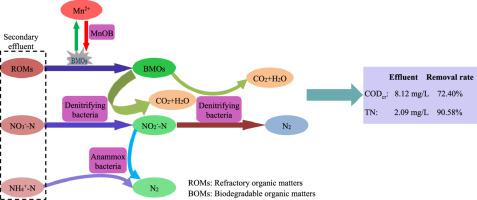Water Research ( IF 11.4 ) Pub Date : 2023-06-01 , DOI: 10.1016/j.watres.2023.120163 Qingfeng Cheng 1 , Hui Tian 2 , Xujing Guo 2 , Shanshan Feng 3 , Erdeng Du 1 , Mingguo Peng 1 , Jie Zhang 4

|
Due to the high operational cost and secondary pollution of the conventional advanced nitrogen removal of municipal wastewater, a novel concept and technique of advanced synergetic nitrogen removal of partial-denitrification anammox and denitrification was proposed, which used the oxidation products of refractory organic matters in the secondary effluent of municipal wastewater treatment plant (MWWTP) by biogenic manganese oxides (BMOs) as carbon source. When the influent NH4+-N in the denitrifying filter was about 1.0, 2.0, 3.0, 4.0, 5.0 and 7.0 mg/L, total nitrogen (TN) in the effluent decreased from about 22 mg/L to 11.00, 7.85, 6.85, 5.20, 4.15 and 2.09 mg/L, and the corresponding removal rate was 49.15, 64.82, 69.40, 76.70, 81.36 and 90.58%, respectively. The proportional contribution of the partial-denitrification anammox pathway to the TN removal was 12.00, 26.45, 39.70, 46.04, 54.97 and 64.01%, and the actual CODcr consumption of removing 1 mg TN was 0.75, 1.43, 1.26, 1.17, 1.08 and 0.99 mg, respectively, which was much lower than the theoretical CODcr consumption of denitrification. Furthermore, CODcr in the effluent decreased to 8.12 mg/L with a removal rate of 72.40%, and the removed organic matters were mainly non-fluorescent organic matters. Kinds of denitrifying bacteria, anammox bacteria, hydrolytic bacteria and manganese oxidizing bacteria (MnOB) were identified in the denitrifying filter, which demonstrated that the advanced synergetic nitrogen removal was achieved. This novel technology presented the advantages of high efficiency of TN and CODcr removal, low operational cost and no secondary pollution.
中文翻译:

以生物源锰氧化物为碳源的二次出水难降解有机物氧化产物高效协同脱氮城市污水
针对城市污水常规深度脱氮运行成本高、存在二次污染等问题,提出了利用难降解有机物氧化产物的部分反硝化厌氧氨氧化反硝化深度协同脱氮的新概念和技术。以生物氧化锰 (BMOs) 为碳源的城市污水处理厂 (MWWTP) 二级出水。当进水 NH 4 +-N在反硝化滤池中约为1.0、2.0、3.0、4.0、5.0和7.0 mg/L,出水总氮(TN)从22 mg/L左右下降到11.00、7.85、6.85、5.20、4.15和2.09 mg/L,相应的去除率分别为49.15、64.82、69.40、76.70、81.36和90.58%。部分反硝化厌氧氨氧化途径对TN去除的贡献比例分别为12.00、26.45、39.70、46.04、54.97和64.01%,去除1 mg TN的实际COD cr消耗量分别为0.75、1.43、1.26、1.17、1.08和0.99 mg,远低于理论反硝化COD cr消耗量。此外,COD cr出水浓度降至8.12 mg/L,去除率为72.40%,去除的有机物主要为非荧光有机物。在反硝化滤池中鉴定出多种反硝化细菌、厌氧氨氧化细菌、水解细菌和锰氧化细菌(MnOB),表明实现了先进的协同脱氮。该新技术具有TN和COD cr去除效率高、运行成本低、无二次污染等优点。











































 京公网安备 11010802027423号
京公网安备 11010802027423号